ORIF - Compression (or bridging) plate
1. Introduction
Comment on illustrations
Throughout this treatment option illustrations of generic fracture patterns are shown, as four different types:
A) Unreduced fracture
B) Reduced fracture
C) Fracture reduced and fixed provisionally
D) Fracture fixed definitively
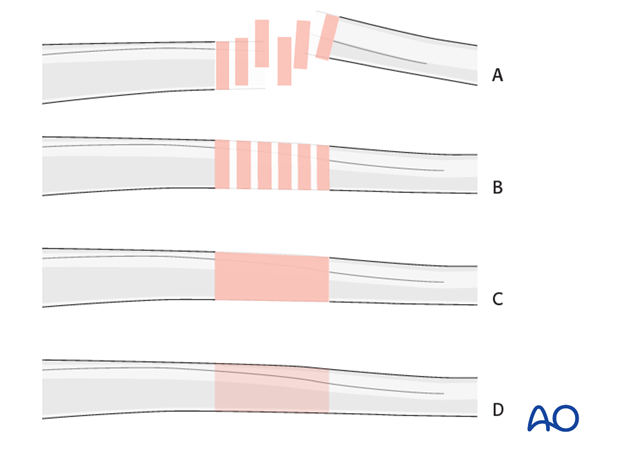
Principles
In intact wedge or fragmented wedge fractures, it is unknown whether absolute stability or bridging stability is the best tactic.
If absolute stability is to be achieved, the surgeon must be careful to respect the bone and soft tissue envelope and apply the appropriate principles.
If the surgeon thinks the fracture pattern or bone quality will not allow for successful absolute stability, then a relative stability construct should be applied.
Whether an absolute or relative stability construct is applied, try to reduce fracture gaps. Due to the relative stiffness of the condylar VA-LCP, major gaps between the fracture fragments can result in higher rates of non-union.
For medial multifragmentary wedge fractures, it is not uncommon to for such a fracture to suffer fixation failure. Extra care must be applied to provide appropriate stability. In some instances, additional medial plate fixation may be necessary.
Main deformities
In general, three major deformities must be managed when performing fixation of the distal femur with condylar VA-LCP:
- Varus/valgus: The frontal plane alignment is determined by the fixation of the femoral articular block to the condylar VA-LCP with the distal locking screws. If the central 7.3 mm screw in the plate is parallel with the tibiofemoral joint surface, this ensures appropriate varus/valgus alignment.
- Rotation: Careful monitoring of the rotation of the limb is observed throughout the operative procedure. The rotation becomes established once a distal screw and a proximal screw have been inserted.
- Flexion/extension (sagittal plane alignment): The alignment of the Condylar VA-LCP on the lateral aspect of the distal femur establishes the presence or absence of any extension or flexion deformity at the fracture site. After the plate fixation to the distal femur, the flexion/extension relationship becomes established (“locked-in") once a second screw is placed in the proximal main femoral fragment.
Hyperextension deformity
The gastrocnemius typically causes a hyperextension deformity of the distal femoral articular block.

Hyperextension deformity must be corrected before fracture fixation. Aids to correcting this hyperextension deformity include:
- Muscle relaxation of the patient
- A bolster in the supracondylar region
- Flexion of the operating table leg segment
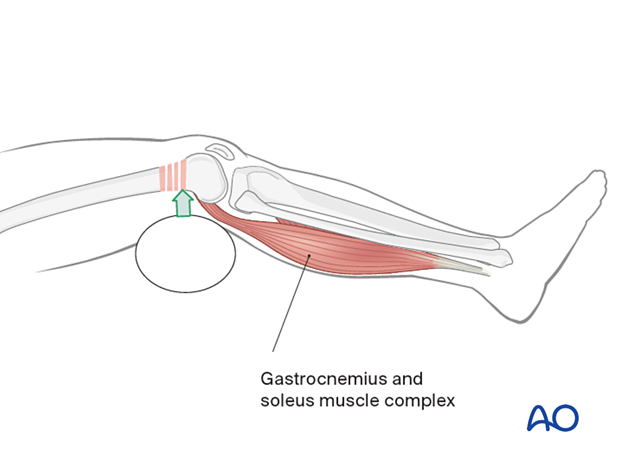
Anatomy of the distal femur
The distal femur has a unique anatomical shape. Seen from an end-on view, the lateral surface has a 10° inclination from the vertical, while the medial surface has a 20–25° slope.
A line is drawn from the anterior aspect of the lateral femoral condyle to the anterior aspect of the medial femoral condyle (patellofemoral inclination) that slopes approximately 10°. These anatomical details are important when inserting screws. In order to avoid joint penetration, these devices should be placed parallel to both the patellofemoral and femorotibial joints planes.
The muscle attachments to the distal femur are responsible for the typical displacement of the distal articular block following a supracondylar fracture, namely shortening with varus and extension deformity. Shortening is due to the pull of the quadriceps and hamstring muscles, while the varus and extension deformity is caused by the unopposed pull of the adductors and gastrocnemius, respectively.
The popliteal vessels, the tibial nerve, and the common peroneal nerve lie near the posterior aspect of the distal femur. Because of this, vascular injuries occur in about 3% and nerve injuries in about 1% of fractures of the distal femur.
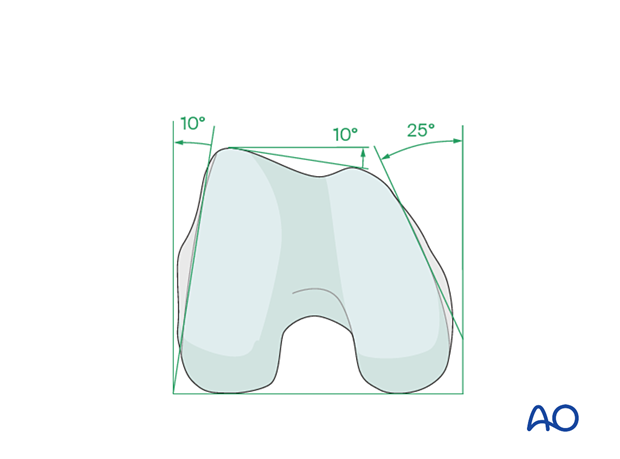
There are no significant arteries, veins, or nerves on the lateral side of the knee.
There may be bleeding from the lateral genicular arteries, which will need to be controlled using diathermy.
At the posterior aspect of the knee lie the popliteal artery, nerve, and vein. It must be borne in mind that these structures can be damaged by the injury or can be damaged by the surgeon during the reconstruction.
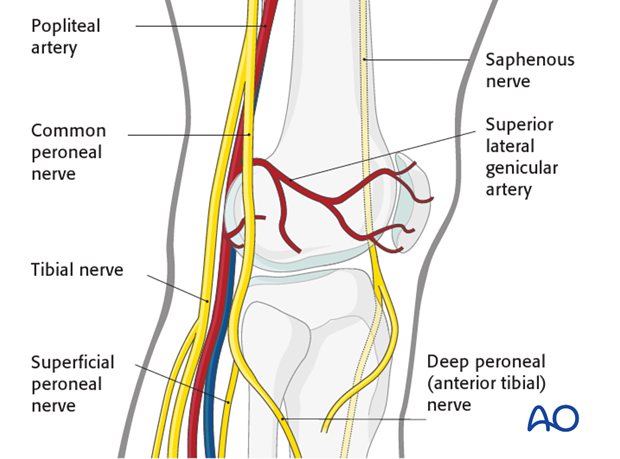
2. Plate selection
Comparison of distal femur implants
The distal-most fixation for various implants is:
- LISS plate: subchondral
- Condylar variable angle locking compression plate (VA-LCP): subchondral
- 95° angled blade plate: 1.5 – 2 cm from the joint
- 95° dynamic condylar screws: 2 cm from the joint
- Retrograde intramedullary nail: variable depending on the vendor. Please be familiar with the nail you will use to ensure you have sufficient distal fixation.
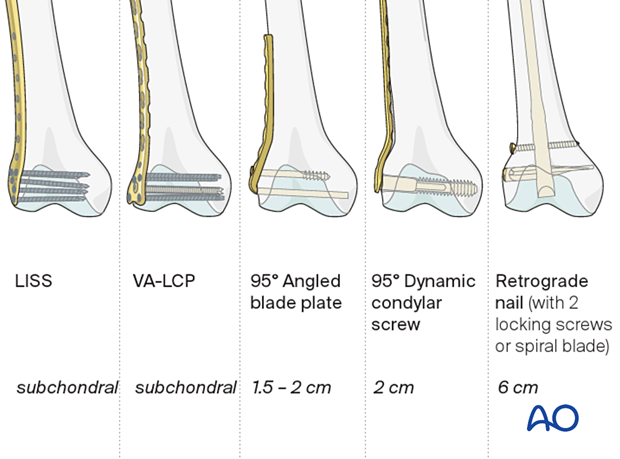
Plate selection
Either the Condylar LCP, DCS, or the angular blade plate may be used for distal femur fractures. Due to its ease of application, the condylar LCP has become the standard lateral distal femur plate. The LCP is additionally favorable in cases with short distal segments and/or osteoporosis.
The DCS is generally less expensive. The angular blade plate may be difficult to apply without creating a deformity.
We will here demonstrate the application of the VA-LCP
Details on the application of alternative plates:
Plate length/number of screws
Whether an absolute or relative stability construct is chosen, sufficient proximal fixation of the plate should be obtained. This typically involves four screws.
The amount of screws placed in the distal end of the plate, should be sufficient to provide appropriate fixation to the distal articular block. A minimum of four screws are typically chosen.
When a relative stability construct is chosen, the plate length should be at least three times as long as the zone of fracture. Nevertheless, most surgeons prefer to apply a plate that spans the entire length of the femur, at least up to the level of the vastus ridge. Bridge plate technique principles should be adhered to where up to 40-50 % of screw holes are filled.
The preoperative x-ray planning template is useful in determining the required length of the condylar VA-LCP and the position of the screws.
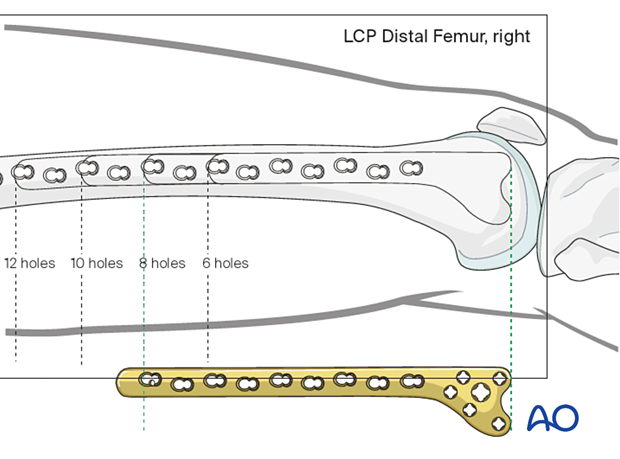
3. Patient preparation and approach
Positioning
This procedure may be performed with the patient in one of the following positions:
- Supine position knee flexed 30°
- Supine position knee flexed 90°
- Lateral decubitus (particularly in obese patients)

Approach
For this procedure, the lateral/anterolateral approach is used.

4. Reduction and fixation of intact wedge
The wedge is reduced to the main proximal fragment.
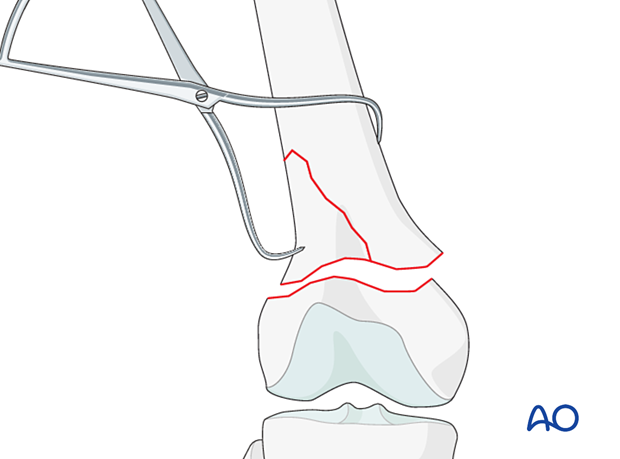
The wedge is fixed to main proximal fragment with a lag screw. The metaphyseal fracture is now reduced from a wedge to a simple fracture.
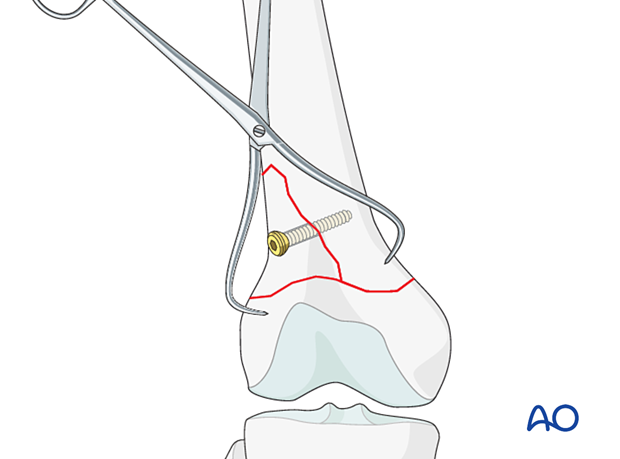
5. Reduction of the metaphysis/diaphysis
The key concept in reduction of the metaphysis is that proper application of the Condylar VA-LCP on the distal femur assures correct frontal plane alignment.
Next, length, rotation, and sagittal plane deformity (hyperextension/hyperflexion) must be addressed.
Open reduction is aided by:
- Bolsters posterior to the supracondylar region, which help correct the hyperextension deformity of the distal femoral articular block. Further aids to reduce the hyper extension deformity is gastrocnemius relaxation and flexion of the operating table leg segment.
- Manual traction or femoral distractor which helps restore length of the limb.
- Direct pointed reduction forceps placement (particularly helpful in spiral fractures of the metaphysis).
- A Hohmann retractor, which may be used as a lever to correct translational displacement.
- The plate itself; by applying the plate in the correct position on the distal femur, appropriate alignment is established when the plate is fixed to the proximal femur.

Assembly of Condylar VA-LCP
Screw the threaded wire guides for the 2.5 mm guide wires into the 5.0 mm and 7.3 mm screw holes of the plate head.
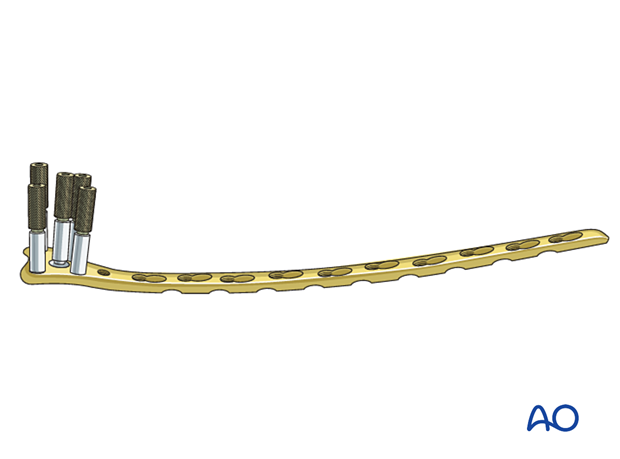
Frontal plane alignment
With one of the reduction aids listed previously, you can get an approximate alignment of the metaphyseal/diaphyseal fracture.
Place the Condylar VA-LCP onto the lateral femoral condyle.
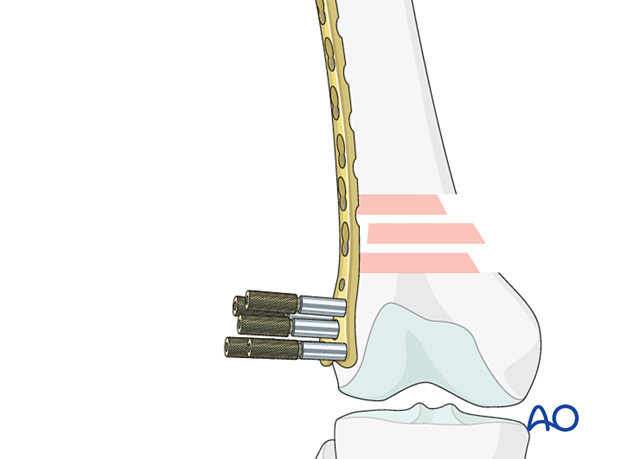
Proper position check - Position on the distal femur
When the plate lies flat on the lateral surface of the condyle, it has been positioned correctly on the distal femoral articular block.
- The anterior edge of the head of the Condylar VA-LCP is usually 1.0-1.5 cm from the anterior aspect of the medial femoral condyle.
- The distal edge of the Condylar VA-LCP is usually 1.5 cm from the distal condylar articular surface.
Readjust plate position if necessary.
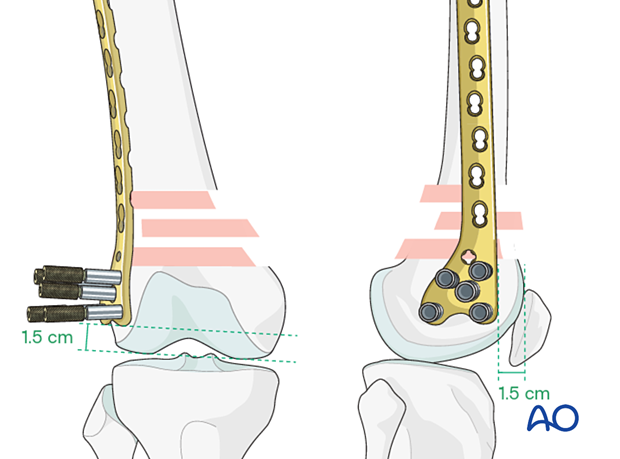
Insertion of first guide wire
Insert a guide wire through the central hole of the plate and check it's position by image intensifier in all planes.
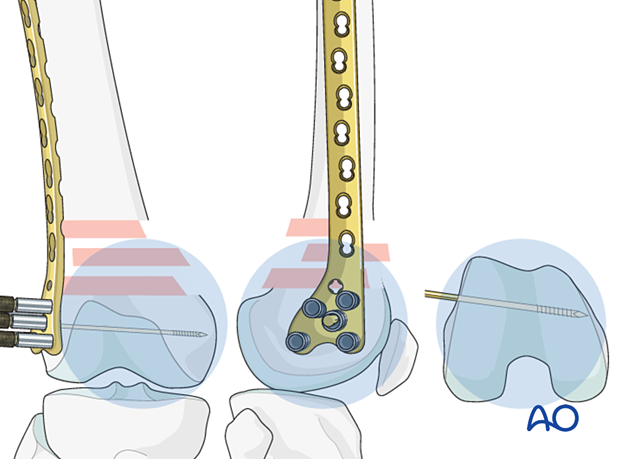
Verification of allignment
Determine the correct position for the central screw of the LCP with the help of guide wires around the joint. Under image intensifier control, pass one guidewire lateral to medial along the tibio-femoral joint line (red). Pass a second guidewire over the anterior the surface of the knee to indicate the plane of the patellofemoral condyles.
The ideal position of the central screw of the LCP is shown by the yellow wire. Note that it is inserted parallel to both the red wire in the frontal plane and is parallel to the green line on the end-on view on the femur. This latter orientation ensures that the plate comes to lie flush with the lateral cortex.
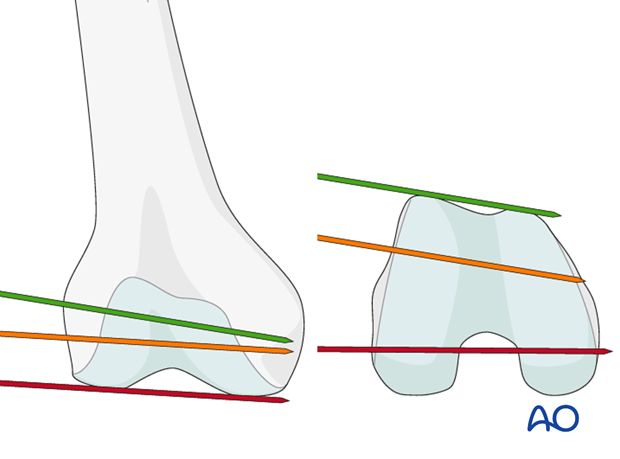
Insertion of second guide wire
Insert a second guide wire in one of the 5.0 mm screw holes to provisionally fix the plate to the femoral articular block.
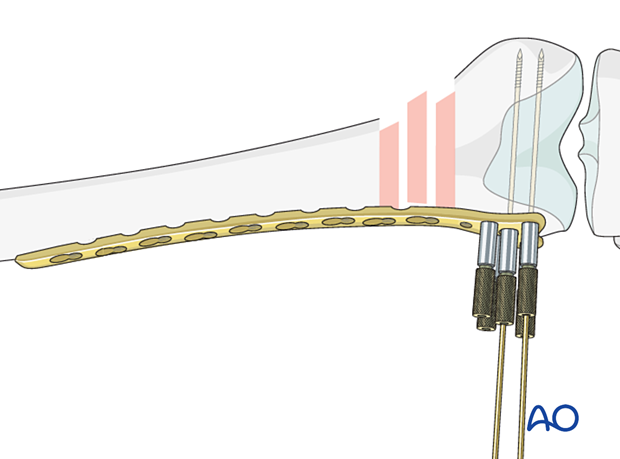
Verification of second guide wire trajectory
Confirm distal plate placement, using visual examination and an image intensifier. Ensure that the guide wires inserted through any of the four most distal 5.0 mm screw holes in the head of the plate are parallel to the tibio-femoral joint plane.
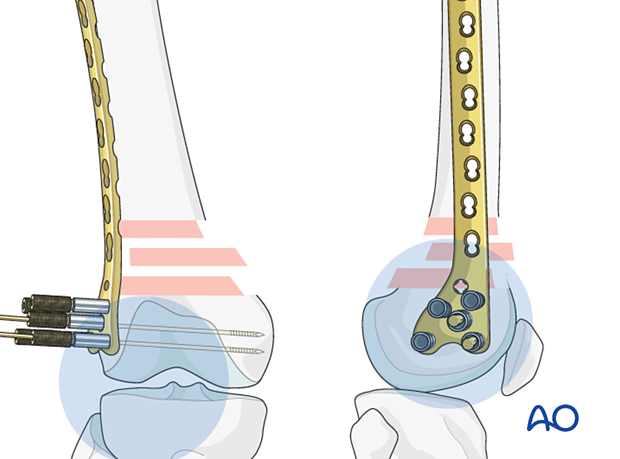
Check that the plate is properly orientated on the lateral femoral condyle. Because the shaft of the femur is frequently out of alignment with the distal femoral articular block, proper plate placement can be determined by matching the shape of the distal portion of the plate to that of the condyle. The position of the plate on the distal femoral articular block at this point will determine the final flexion/extension reduction. This reduction is important because this fracture usually falls into extension; this must be prevented.
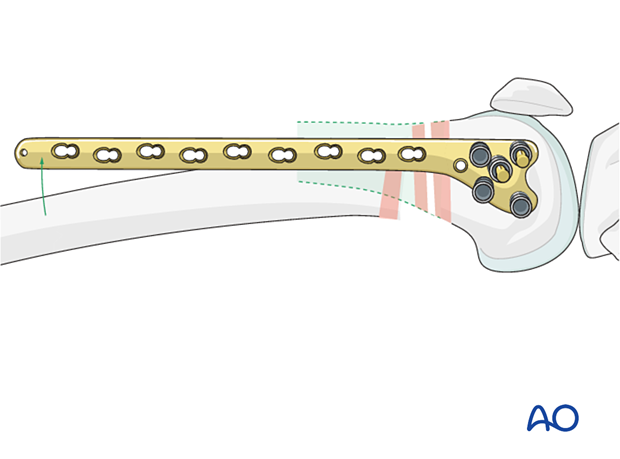
6. Distal plate fixation
Screw length measurement in distal femoral articular block
Advance the guide wires until they reach the medial cortex of the femoral condyle, but they should not penetrate the cortex.
Use the measuring device to indirectly measure the lengths of the screws using the guide wires.
For proper measurement, the measuring device must contact the end of the threaded wire guide. This will place the tip of the screw at the tip of the guidewire.
The self-drilling, self-tapping flutes of the 7.3 mm and 5.0 mm screws make predrilling and pre-tapping unnecessary in most cases. In dense bone, the lateral cortex can be predrilled, if necessary.
- Use the 5.0 mm drill bit for 7.3 mm screws.
- Use the 4.3 mm drill bit for 5.0 mm screws.
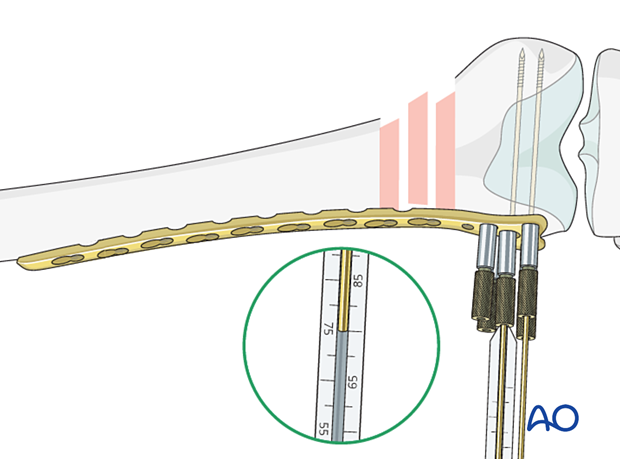
Distal screw insertion
The central wire guide is removed and the central screw (7.3 mm) is inserted over the guidewire, using the torque-limiting power screwdriver. Self-tapping screws are used.
Inserting only one screw at this point allows the correction of small deformities in the sagittal plane (on the lateral x-ray).
After confirming that the plate is in the correct position on the distal femur when viewed on a lateral x-ray, the additional screws (5.0 mm) should be inserted into the distal femoral articular block.
Regular locking screws or variable angle screws may be chosen based on any previously inserted lag screws.
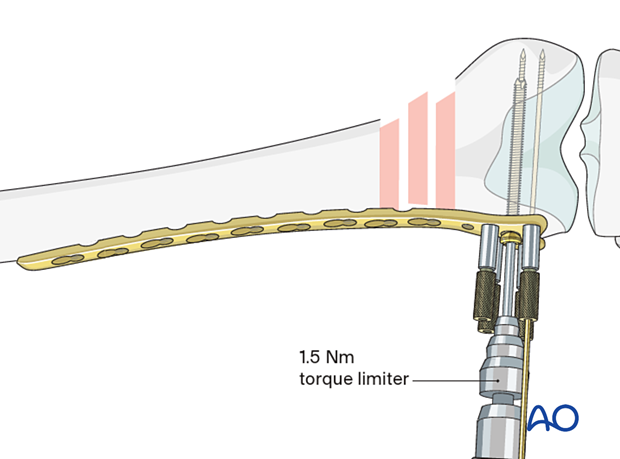
Length
Use manual traction or femoral distractor to restore length.
Generally, the length may be assessed by evaluating overlap or distraction of the posterior cortex of the femur.
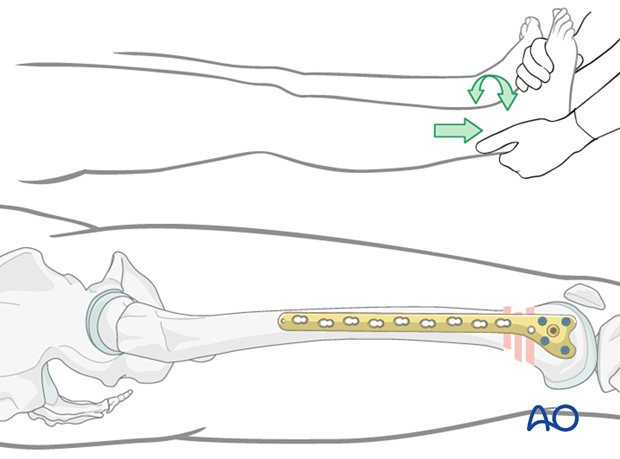
Temporary plate fixation
Align the plate with the proximal mid-lateral cortex and secure it in position with a sharp pointed reduction clamp.
Use of a Verbrugge clamp is not advised.
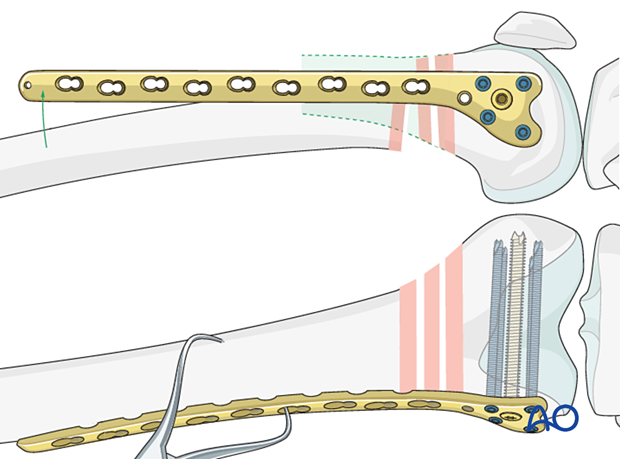
7. Intraoperative radiological assessment
Establishment of rotation
Place a bolster underneath the buttock of the involved extremity. A simple “rule-of-thumb” is that the foot should be externally rotated 10° after fixation of the supracondylar fracture. If the rotation is correct, the anterior superior iliac spine, the center of the patella and the second toe should be in line. Additionally, and more precisely, the rotation can be assessed using the image intensifier with the lesser-trochanter sign or the Bouvier cord method (see below).

Assessment of rotation
Compare the profile of the lesser trochanter with that of the contralateral leg (lesser trochanter shape sign), holding the leg so that the patella faces anteriorly on both sides.
Before positioning the patient, store the profile of the lesser trochanter of the intact opposite leg (patella facing anteriorly) in the image intensifier.
The illustration shows the lesser trochanteric profile of the intact opposite side.

Malrotation
In cases of malrotation, the lesser trochanter is of a different profile when compared to that of the contralateral leg.
Take care to assess rotation with the patella facing directly anteriorly.

Verification of successful reduction
It is very important to restore the biomechanical axis of the lower limb. The normal biomechanical axis follows a line from the center of the femoral head, through the center of the proximal tibia and then through the center of the ankle joint. This axis can be checked intraoperatively by using a piece of cable, such as the diathermy cord. The cord is stretched from the iliac spine across the patella to the cleft between the first and second toes.
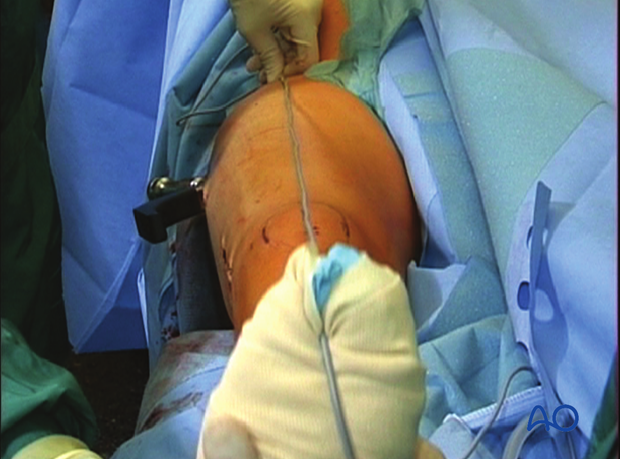
If rotation is correct, this cord will pass over the midline of the patella, and slightly medial to the tibial eminence. The radiological landmarks of the center of the femoral head, the center of the knee and the center of the ankle joint should all be in line if the mechanical axis of the femur is correct.
Another method of assessing rotational reduction is to compare the cortical thickness above and below the fracture. If a shaft fracture is multifragmentary, the image intensifier cannot be used to compare cortical diameters on each side of the fracture.
Not only must the biomechanical axis be restored, but care should be taken to ensure that there is no malrotation of the distal femur on the proximal femur.
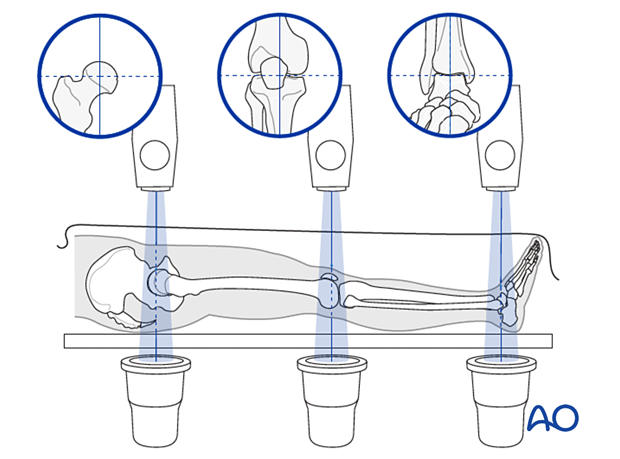
This illustration shows the longitudinal axes of the lower limb.
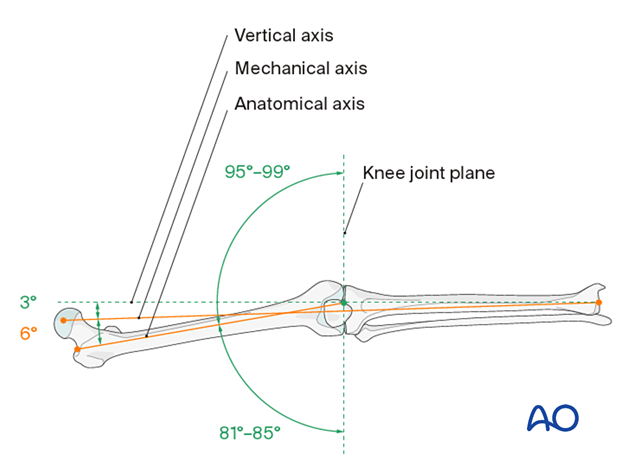
Confirmation of length
To ensure that femoral length has been restored, many options exist:
- One option involves reducing the fracture fragments anatomically, either directly or indirectly with fluoroscopic control.
- Even in multifragmentary fractures, there are usually a few main fracture segments that can assist the surgeon in ensuring that the appropriate length has been obtained.
- Another option involves taking radiographic images of the contralateral distal femur for comparison.
- A radiographic ruler can be used to measure the length of both femora. In this technique, it is important that the x-ray beams are perpendicular to the OR table and that the ruler is parallel to the OR table.

8. Use of the articulated tension device (for compression)
Application of the articulated tension device
It is strongly recommended to apply controlled compression to the metaphyseal fracture component using the articulated tension device when there is direct contact between the proximal and distal main fragments in simple transverse or wedge fractures.
Multifragmentary or osteoporotic metaphyseal fractures should not be compressed.
After the Verbrugge clamp is loosely applied, the articulated tension device is engaged in the proximal hole of the plate and fixed to the bone with a bicortical screw. An articulating wrench is then used to compress the fracture zone. When this occurs the strain gauge on the device goes from the green zone to the yellow zone and finally to the red zone. During the use of this wrench, the fracture complex must be monitored to ensure that no undesirable displacement occurs.
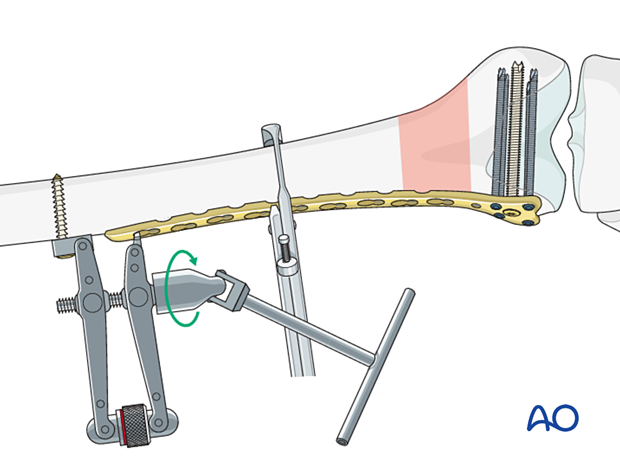
Eccentric screw insertion
After the appropriate tension is applied, you may insert a screw into the proximal segment. Place this screw eccentrically in the standard hole to allow for slight additional compression of the fracture site.
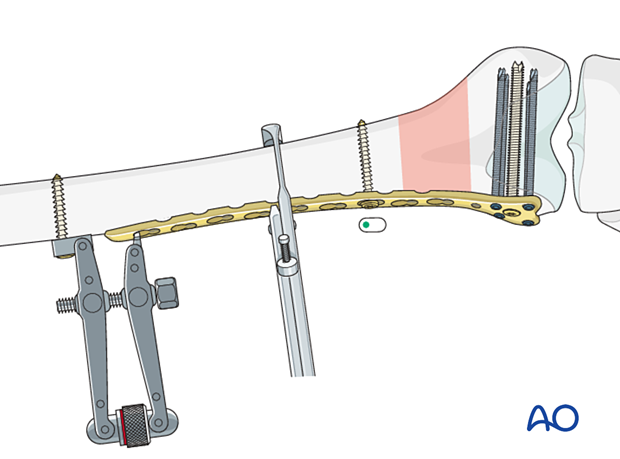
9. Fixation of plate to proximal fragment
Additional screw insertion
Insert additional screws for a total of 4-5 screws distally (locking, variable angle locking head screws) and 4-5 bicortical screws proximally.
Proximally, either standard bicortical screws (as illustrated), or locking-head screws may be used. Locking head screws are only useful in osteoporotic bone. A standard screw is inserted after drilling with a 3.2 mm drill bit. A 5.0 mm locking-head screw is inserted after drilling with a 4.3 mm drill bit through the threaded drill sleeve.
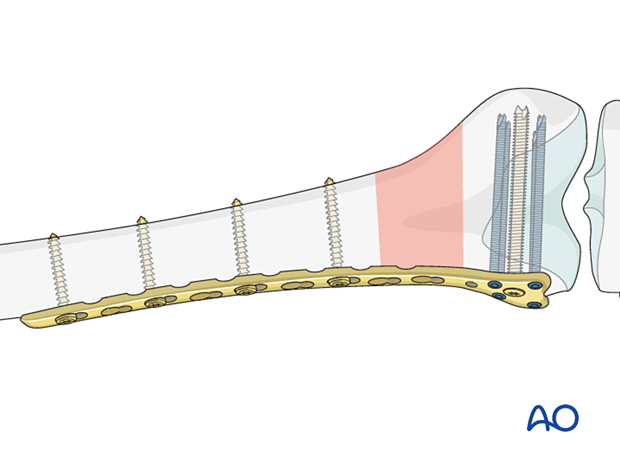
Final check of fracture reduction and fixation
Gently move the knee through a full range of motion. Carry out a clinical assessment of the rotational profile. Finally, perform a radiographic assessment of the frontal-plane alignment (varus/valgus) and sagittal-plane alignment (extension/flexion).
Examine the knee for any ligamentous instability.
Wound closure
Irrigate all wounds copiously. Close the iliotibial tract using absorbable sutures. The use of suction drains may be considered. Close the skin and subcutaneous tissue in the routine manner.
Double plating
If the construct is deemed insufficient to guarantee stability, a second plate may be applied medially.
For more details on the application of a medial plate, please see the procedure on double plating.
10. Aftercare
Impediments to the restoration of full knee function after distal femoral fracture are fibrosis and adhesion of injured soft tissues around the metaphyseal fracture zone, joint capsular scarring, intra-articular adhesions, and muscle weakness.
Early range of motion helps restore movement in the early postoperative phase. With stable fracture fixation, the surgeon and the physical therapy staff will design an individual program of progressive rehabilitation for each patient.
The regimens suggested here are for guidance only and not to be regarded as prescriptive.
Functional treatment
Unless there are other injuries or complications, knee mobilization may be started immediately postoperatively. Both active and passive motion of the knee and hip can be initiated immediately postoperatively. Emphasis should be placed on progressive quadriceps strengthening and straight leg raises. Static cycling without load, as well as firm passive range of motion exercises of the knee, allow the patient to regain optimal range of motion.
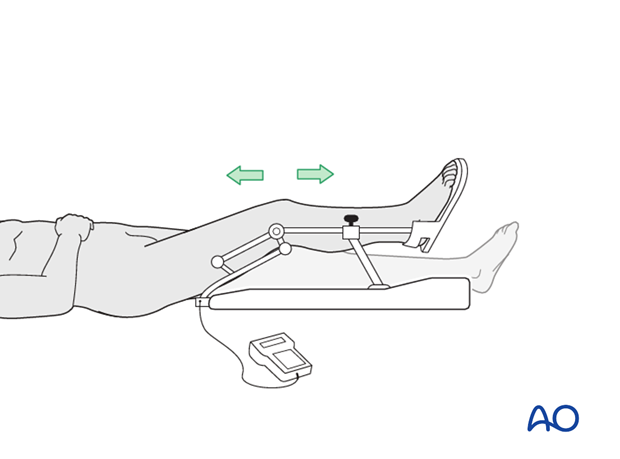
Weight bearing
Touch-down weight-bearing (10-15 kg) may be performed immediately with crutches, or a walker. This will be continued for 6-10 weeks postoperatively. This is mostly to protect the articular component of the injury, rather than the shaft injury. Touch-down weight-bearing progresses to full weight-bearing gradually, over a period of 2 to 3 weeks (beginning at 6–10 weeks postoperatively). Ideally, patients are fully weight-bearing, without devices (e.g., cane) by 12 weeks.
Follow-up
Wound healing should be assessed at two to three weeks postoperatively. Subsequently 6-week, 12-week, 6-month, and 12-month follow-ups are usually made. Serial x-rays allow the surgeon to assess the healing of the fracture.
Implant removal
Implant removal is not essential but should be discussed with the patient if there are implant-related symptoms after consolidated fracture healing.
Thrombo-embolic prophylaxis
Thrombo-prophylaxis should be given according to local treatment guidelines.













